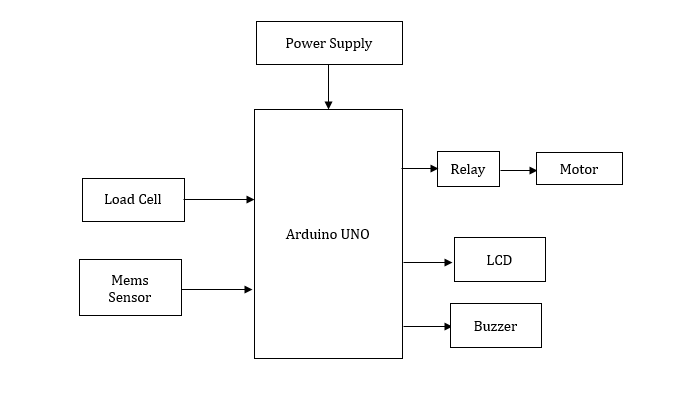Arduino Based Vehicle Overload Detection System for Prevention of Accidents
Objective
The main objective of this project is to develop an Arduino-based vehicle overload detection system aimed at preventing accidents by monitoring and alerting against vehicle overloading, thereby enhancing road safety
Abstract
In the context of road safety, vehicle overloading remains a persistent concern, posing a risk of accidents, infrastructure damage, and potential harm to human life. This project introduces an innovative solution for mitigating this issue through an Arduino-based Vehicle Overload Detection System (VODS). The system incorporates load cell, MEMS sensor, an LCD display, and a buzzer to effectively detect and prevent vehicle overloading, contributing to improved road safety.
The VODS is designed to monitor the weight distribution on a vehicle using strategically placed load cells and detect variations in vehicle tilt and acceleration through MEMS sensors. Upon detecting an overload condition, the system promptly triggers a response by stopping the motor, which prevents further loading, and immediately displays a warning on the LCD screen. Simultaneously, it activates an audible alert through the buzzer. This rapid reaction not only averts potential accidents resulting from overloading but also extends the vehicle's operational life by minimizing wear and tear. The Arduino-based Vehicle Overload Detection System represents a cost-effective and efficient approach to addressing the critical issue of vehicle overloading. Its monitoring capabilities, coupled with instant warnings and alerts, establish it as a valuable tool in enhancing road safety and reducing the risks associated with overloading.
Keywords: Arduino, MEMS sensor, overload detection, accident prevention and alert.
NOTE: Without the concern of our team, please don't submit to the college. This Abstract varies based on student requirements.
Block Diagram

Specifications
Hardware Components:
- Arduino UNO
- Power Supply
- Load Cell
- MEMS Sensor
- DC Motor
- LCD
- Relay
- Buzzer
- Arduino IDE
- Embedded C
Learning Outcomes
- Arduino pin diagram and architecture
- How to install Arduino IDE software
- Setting up and installation procedure for Arduino
- Introduction to Arduino IDE
- Basic coding in Arduino IDE
- Working of LCD
- Interface LCD with Arduino
- Working of power supply
- About Project Development Life Cycle:
- Planning and Requirement Gathering (software’s, Tools, Hardware components, etc.,)
- Schematic preparation
- Code development and debugging
- Hardware development and debugging
- Development of the Project and Output testing
- Practical exposure to:
- Hardware and software tools.
- Solution providing for real time problems.
- Working with team/ individual.
- Work on Creative ideas.
- Project development Skills
- Problem analyzing skills
- Problem solving skills
- Creativity and imaginary skills
- Programming skills
- Deployment
- Testing skills
- Debugging skills
- Project presentation skills


 Paper Publishing
Paper Publishing
